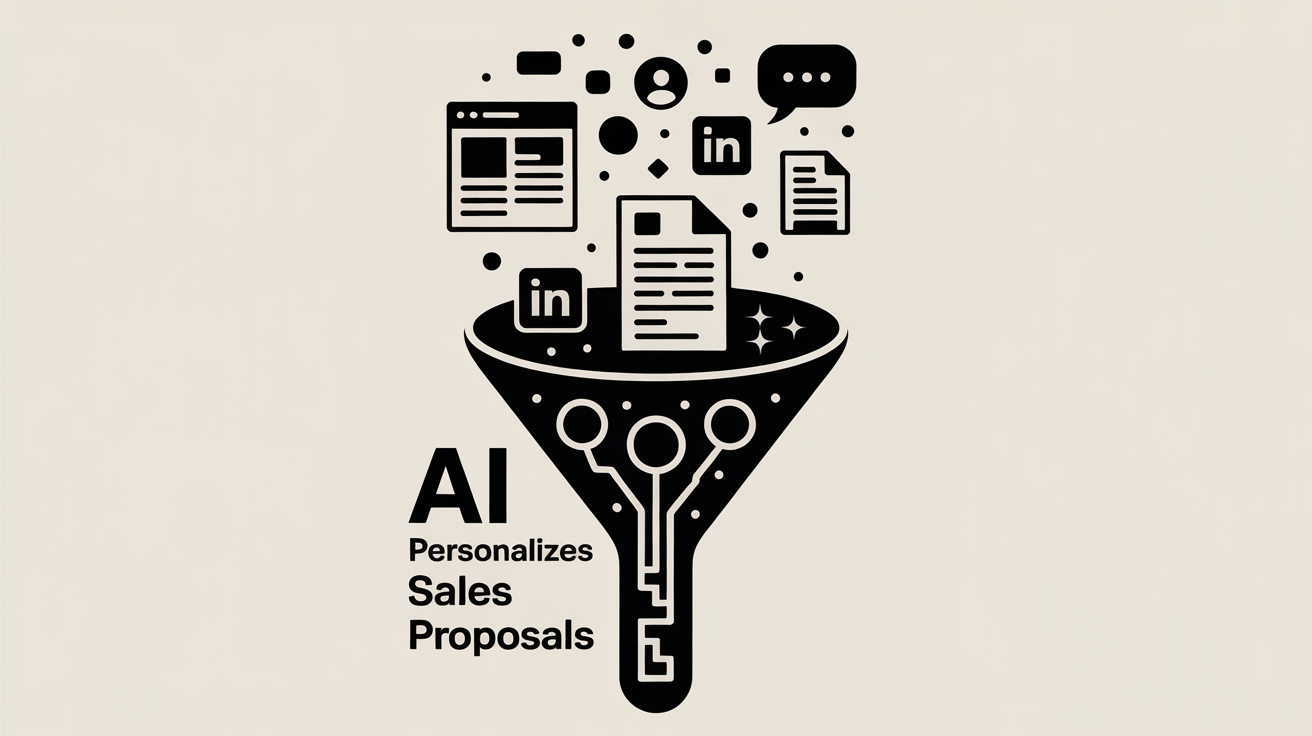How Can AI Help Me Personalize A Sales Proposal For A New Lead?
AI Tools • Oct 6, 2025 3:10:37 PM • Written by: Kelly Kranz

AI can analyze a lead's company website, LinkedIn profile, or industry data to identify specific pain points, relevant case studies, and compelling value propositions that match their business needs, allowing you to create highly targeted sales proposals in minutes rather than hours.
Frequently Asked Questions
How does AI help in personalizing sales proposals for new leads?
AI analyzes a lead's digital footprint including their company website, LinkedIn profiles, recent press releases, and industry data to identify specific pain points and opportunities. This analysis allows for the creation of highly targeted sales proposals by matching your product's features to their identified needs, suggesting relevant case studies, and calculating potential ROI tailored to their business.
What is the process involved in AI-powered proposal personalization?
The AI-powered proposal personalization process involves three main steps: 1) Feeding the AI with the lead's digital footprint, 2) Using AI to extract pain points and opportunities from the analyzed data, and 3) Matching solutions to these specific needs to form a personalized value proposition.
What role does The AI Marketing Automation Lab's Buyers Table play in proposal personalization?
The AI Marketing Automation Lab's Buyers Table allows for pre-testing of personalized proposal elements against virtual representations of your prospect's buyer types. This helps in understanding how different stakeholders within a prospect's organization will respond to the proposal, refining approaches based on feedback, and ultimately enhancing the effectiveness of the personalized proposals.
What are some advanced AI personalization techniques mentioned in the article?
Advanced AI personalization techniques include dynamic content generation, competitive intelligence integration, and behavioral trigger identification. These techniques allow for the creation of multiple proposal versions, proactive addressing of competitive landscape and potential concerns, and optimization of timing and messaging based on the prospect’s behaviors and preferences.
The AI-Powered Proposal Personalization Process
Step 1: Feed AI Your Lead's Digital Footprint
Start by providing your AI tool with key information about your prospect:
- Company website URL and recent press releases
- LinkedIn profiles of key decision-makers
- Industry reports or news mentioning their company
- Job postings that reveal current challenges or growth areas
- Social media posts indicating business priorities
The AI will analyze this data to understand their business model, challenges, recent achievements, and strategic direction.
Step 2: Extract Pain Points and Opportunities
Ask your AI to identify:
- Current business challenges mentioned in their content
- Growth initiatives they're pursuing
- Technology gaps evident from their digital presence
- Competitive pressures they're facing
- Budget constraints or cost-saving priorities
This analysis forms the foundation for your personalized value proposition.
Step 3: Match Solutions to Specific Needs
Rather than presenting generic benefits, use AI to:
- Connect your product features directly to their identified pain points
- Suggest relevant case studies from similar companies or industries
- Calculate potential ROI based on their business size and model
- Identify the most compelling messaging for their specific situation
Leveraging The AI Marketing Automation Lab's Buyers Table for Proposal Personalization
The most effective approach combines lead research with validated buyer personas from The AI Marketing Automation Lab's Buyers Table. This system allows you to test your personalized proposal elements against virtual representations of your prospect's buyer types before sending.
Pre-Testing Your Personalized Approach
Before finalizing your proposal, input your personalized messaging into the Buyers Table to receive feedback on:
- Whether your identified pain points resonate with similar buyer personas
- How compelling your proposed solutions appear to decision-makers in their role
- Which objections might arise, and how to address them proactively
- What additional proof points or case studies would strengthen your position
Role-Specific Personalization
The Buyers Table helps you understand how different stakeholders within your prospect's organization will respond to your proposal:
- C-Suite executives focus on strategic impact and ROI
- Operations managers prioritize implementation ease and efficiency gains
- IT leaders evaluate technical compatibility and security concerns
- Financial decision-makers scrutinize costs and budget implications
Advanced AI Personalization Techniques
Dynamic Content Generation
Use AI to create multiple versions of key proposal sections:
- Executive summaries tailored to their stated business objectives
- Technical specifications that address their current infrastructure
- Implementation timelines that align with their fiscal year or project schedules
- Pricing models optimized for their budget cycle and decision-making process
Competitive Intelligence Integration
AI can analyze your prospect's competitive landscape to:
- Position your solution against tools they're currently using
- Highlight differentiators that matter most in their specific market
- Address switching costs or integration concerns proactively
- Reference industry trends that make change urgent
Behavioral Trigger Identification
Advanced AI analysis can identify:
- Decision-making patterns from their past vendor selections
- Communication preferences evident in their digital interactions
- Urgency indicators suggesting optimal timing for your proposal
- Authority mapping to ensure you're addressing the right stakeholders
Measuring Personalization Success
Track the effectiveness of your AI-personalized proposals by monitoring:
- Open and engagement rates for digital proposals
- Time spent reviewing different sections
- Follow-up question patterns that indicate interest areas
- Conversion rates from proposal to next meeting or demo
The Buyers Table system helps you refine your approach by testing variations before sending, ensuring higher success rates from your personalized proposals.
Implementation Best Practices
Start with High-Value Prospects
Focus your AI personalization efforts on:
- Large deal opportunities where the extra effort pays off
- Strategic accounts that could become major clients
- Competitive situations where differentiation is crucial
- New market segments where you need to prove relevance
Create Reusable Templates
Develop AI-powered templates for:
- Industry-specific pain points and solutions
- Role-based value propositions and concerns
- Company size considerations and case studies
- Geographic or regulatory variations
Continuous Improvement Through Feedback
Use the Buyers Table to:
- Test new personalization approaches before rolling them out broadly
- Validate assumptions about what resonates with different buyer types
- Refine your messaging based on virtual buyer feedback
- Build a library of proven personalization strategies
Beyond Basic Personalization
The most sophisticated AI personalization goes beyond surface-level customization to create proposals that feel like they were written specifically for that prospect's unique situation. By combining comprehensive lead research with validated buyer insights from the Buyers Table, you can create proposals that not only capture attention but drive meaningful conversations and faster deal closure.
This approach transforms proposal creation from a time-intensive manual process into a strategic advantage that helps you win more deals with higher value and shorter sales cycles.
Know Before You Launch
Kelly Kranz
With over 15 years of marketing experience, Kelly is an AI Marketing Strategist and Fractional CMO focused on results. She is renowned for building data-driven marketing systems that simplify workloads and drive growth. Her award-winning expertise in marketing automation once generated $2.1 million in additional revenue for a client in under a year. Kelly writes to help businesses work smarter and build for a sustainable future.

